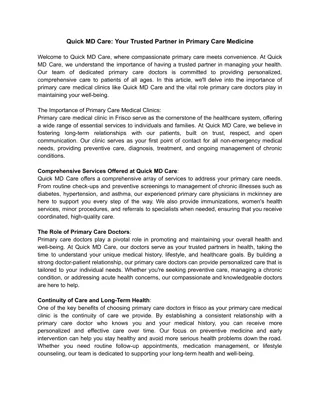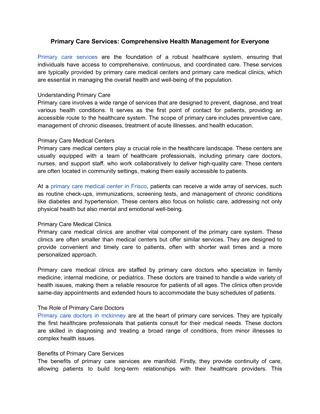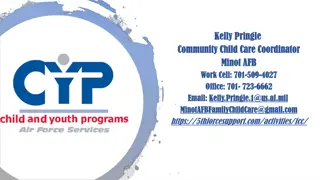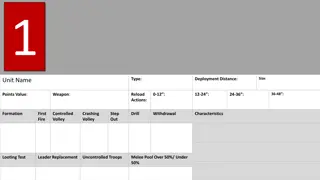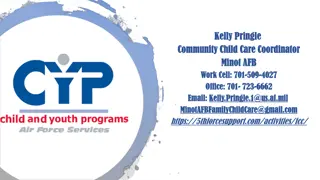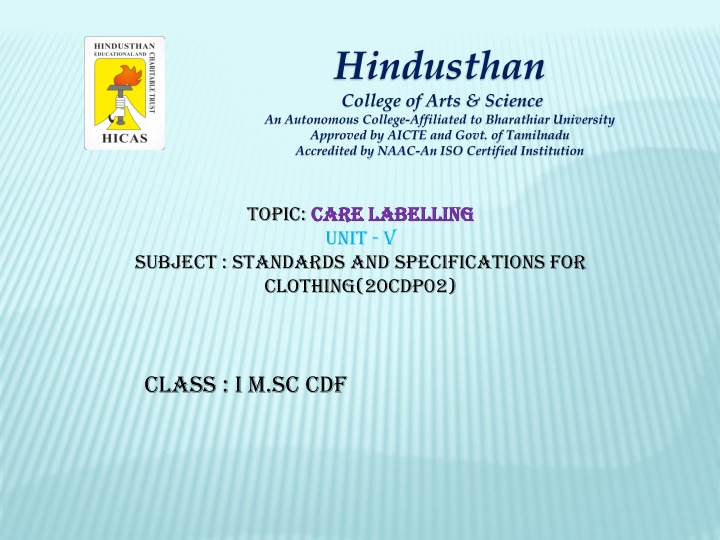
Care Labelling for Clothing Standards and Specifications
Discover the importance of care labelling in maintaining the quality and longevity of apparel. Learn about the regulations, guidelines, and responsibilities surrounding care labels for textiles and garments.
Download Presentation

Please find below an Image/Link to download the presentation.
The content on the website is provided AS IS for your information and personal use only. It may not be sold, licensed, or shared on other websites without obtaining consent from the author. If you encounter any issues during the download, it is possible that the publisher has removed the file from their server.
You are allowed to download the files provided on this website for personal or commercial use, subject to the condition that they are used lawfully. All files are the property of their respective owners.
The content on the website is provided AS IS for your information and personal use only. It may not be sold, licensed, or shared on other websites without obtaining consent from the author.
E N D
Presentation Transcript
Hindusthan College of Arts & Science An Autonomous College-Affiliated to Bharathiar University Approved by AICTE and Govt. of Tamilnadu Accredited by NAAC-An ISO Certified Institution TOPIC: care care labelling labelling Unit - V SUBJECT : STANDARDS AND SPECIFICATIONS FOR CLOTHING(20CDP02) Class : I M.SC CDF
CARE LABELLING CARE LABELLING Apparels and textiles are soiled during their normal use. From economic point of view these items must be cleaned and refurbished for reuse without substantially altering their functional and aesthetic properties. Consumers should be provided the knowledge of various processing conditions for care of the apparels. This is the joint responsibility of the apparel industry and the textile care industry. According to Federal Trade Commissions (FTC) rule 16 CFK 423 - apparels should have permanent care label that provides information about their regular care. The purpose of the rule is to give the consumers accurate care information to extend the useful life of the apparel.
CARE LABELLING CARE LABELLING Care labels should not be considered as a guarantee or a quality mark of the product. Manufacturers and importers of textiles, apparel and piece goods (sold to consumers for making wearing apparel); and any organization that controls the manufacturing or import of textile wearing apparel or piece goods for making wearing apparel are covered in this rule.
CARE LABELLING CARE LABELLING Care label means a permanent label or tag. Containing regular care information and instructions - attached or affixed It will not become separated from the product - will remain legible during the useful life of the product.
CARE LABELLING CARE LABELLING A care label is for any information you want to attach to your garment or clothing. Sometimes they include laundry symbols to indicate how a particular item should best be washed, dry cleaned or ironed. Or information on the composition of the material.
INTRODUCTION INTRODUCTION Care instructions are small solutions to big problems. Care labels provide guidelines to consumers about apparel care, and the best cleaning procedures to be used for a particular combination of fabric, thread decoration and construction techniques. Following the instructions on the care labels is an assurance that the appearance and fit of the garment will be maintained after repeated cleaning treatments. From a manufacturer s point of view, damage to garments from incorrect cleaning methods can lead to complaints; costly customer returns and a bad image. Whereas accurate and clearly written care labels can prevent customer dissatisfaction. From a consumer s point of view, accurate and clearly written care instructions serve as a cleaning guide and influence purchase. Garments with ease of care are often preferred over garments with complicated or difficult to understand care procedures. Many different care labelling systems have evolved over the world. Some have been established as a governmental regulation, while others are international standards. Not all of them however, are mandatory.
MEANING MEANING Even though they re small, care instructions on clothing can be lifesavers. For example, garment care labels offer guidelines to consumers about the best cleaning methods for a specific item of clothing and are used in conjunction with fabric specifics. Ensuring garments are cared for as directed on the label will preserve their look and wearability.
FACTS ABOUT CARE LABEL FACTS ABOUT CARE LABEL The country where the garment was made is typically listed as the country of origin on a care label. Labels should be permanently attached to provide the customer easy access and ensure that no items can be passed off as new when they are not. Clothes labels are typically located on the side or bottom of the clothing. The person who orchestrates production is responsible for the accuracy of care instructions. Products must be labeled before they re sold, but sometimes the labels are printed on after importation.
LABELING CLOTHING LABELING CLOTHING Attach labels so consumers can easily see or find them at the point of sale. If packaging gets in the way, place additional care information on the outside of the package or on a hang-tag attached to the product. Labels must be attached permanently and securely. Labels must be legible during the useful life of the product. A garment with two or more parts that is sold as a unit needs only one care label if the care instructions are the same for all parts. Attach the label to the major piece of the suit. If the suit pieces require different care instructions or like coordinates are designed to be sold separately, each item must have its own care label.
WHEN TO LABEL GARMENTS WHEN TO LABEL GARMENTS Domestic manufacturers must attach care labels to finished products before they sell them. Importers must ensure that care labels are attached to products before they sell them in the U.S., but care labels don't have to be attached to products when they enter the U.S.
WHAT ARE CARE LABELS? WHAT ARE CARE LABELS? The label which provides information on the treatment of various kinds of clothes that does not cause irreversible damage to the article. Commercial companies (wholesalers, retailers, importers, etc. ) are required to ensure correct information of the care treatment of textile products. The symbols refer to the part most sensible to the care treatment of a textile article. This includes: Colouring Finishing Accessories ( such as buttons, zips ) https://textilelearner.net/care-label-guidelines-for-garments/
WHAT ARE CARE LABELS? WHAT ARE CARE LABELS? The label which provides information on the treatment of various kinds of clothes that does not cause irreversible damage to the article. Commercial companies (wholesalers, retailers, importers, etc. ) are required to ensure correct information of the care treatment of textile products. The symbols refer to the part most sensible to the care treatment of a textile article. This includes: Colouring Finishing Accessories ( such as buttons, zips )
CARE CARE LABELLING LABELLING SYSTEMS SYSTEMS There are five care labelling systems which are generally used on care labels. These systems are: The International Care Labelling System - GINETEX The Japanese Care Labelling System The Canadian Care Labelling System The European Care Labelling System The American Care Labelling System
DIFFERENT PROCESS COVERED IN CARE DIFFERENT PROCESS COVERED IN CARE LABELLING LABELLING a. Laundering: A process intended to remove soil or stains by washing with an aqueous detergent solution (and possibly bleach) and normally including subsequent rinsing, extracting and drying. b. Chlorine bleach: A process carried out in an aqueous medium before, during or after washing processes, requiring the use of chlorine based bleaching agent for the purpose of removing stains and/or improving whiteness. c. Non-chlorine bleach: A bleach that does not release the hypochlorite ion in solution, for example sodium perborate, sodium percarbonate, etc.
DIFFERENT PROCESS COVERED IN CARE DIFFERENT PROCESS COVERED IN CARE LABELLING LABELLING d. Dry-cleaning: A process for cleaning textile articles by means of organic solvents (eg, petroleum, perchlorethylene, fluorocarbon). This process consists of cleaning, rinsing, spinning and drying. e. Tumble drying: A process carried out on a textile article after washing, with the intention of removing residual water by treatment with hot air in a rotating drum. f. Ironing: A method of pressing using a heated hand iron sometimes together with moisture or steam, and a gliding motion. g. Pressing: A process of smoothing and shaping by heat and pressure, with or without the presence of steam.
OTHER TERMINOLOGIES IN CARE LABELS OTHER TERMINOLOGIES IN CARE LABELS a. Detergent: A cleaning agent containing one or more surfactants as the active ingredient(s). b. Soap: A cleaning agent usually consisting of sodium or potassium salts of fatty acids. c. Bleach (in care of textiles): A product for brightening and aiding the removal of soils and stains from textile materials by oxidation that is inclusive of both chlorine and non-chlorine products. d. Cleaning agent: A chemical compound or formulation several compounds which loosens, disperses, dissolves, or emulsifies soil to facilitate removal by mechanical action.
OTHER TERMINOLOGIES IN CARE OTHER TERMINOLOGIES IN CARE LABELS LABELS e. Consumer care: Cleaning and maintenance procedures as customarily undertaken by the ultimate user. e. f. Professional care: Cleaning and maintenance procedures requiring the services of a person specially trained or skilled in their use. g. Refurbish: To brighten or refresh up and restore to wearability or use by cleaning such as dry-cleaning, laundering, or steam cleaning. h. Stain removal: A cleaning procedure for localised areas with cleaning agents and mechanical action specific to the removal of foreign substances present. i. Solvent relative humidity: The humidity of air over dry-cleaning bath and in equilibrium with the solvent and small amount of water.
REQUIREMENTS OF CARE LABELS REQUIREMENTS OF CARE LABELS Care labels should not be visible from outside and should not be inconvenient to the wearer. Should be easily visible and not hidden lead to difficulties in conveying information. Symbols and letters on the labels shall be legible throughout useful life of garment. The labels for a particular style should be positioned at one place in all pieces. If not readily seen due to packaging, care information must be repeated on the outside of the package or on a hangtag attached to the product. Care labels should be made of suitable material with resistance to the care treatment indicated in the label
REQUIREMENTS OF CARE LABELS REQUIREMENTS OF CARE LABELS Label and symbols should be large enough so that they are easily visible and readable and they denote the maximum permissible treatment for an apparel. The consumers should easily understand the symbols irrespective of the language. The care instruction symbols are applicable to whole of the garment including trimmings, zippers, linings, buttons, etc unless otherwise mentioned by separate labels. The care symbols selected should give instructions for the most severe process or treatment the garment can withstand while being maintained in a serviceable condition without causing a significant loss of its properties.
TYPES OF LABELS TYPES OF LABELS Brand label. If only brand is used on package of a product, this is called brand label. ... Grade label. Some products have given grade label. ... Descriptive label. Descriptive label give information about the feature, using instruction, handling, security etc. ... Informative label
WHAT ARE CARE CODE? WHAT ARE CARE CODE? Care codes are the internationally recognized symbols which are used for caring of garments in case of cleaning and ironing. These labels on which these codes are drawn or printed are called care labels
THANK YOU THANK YOU


